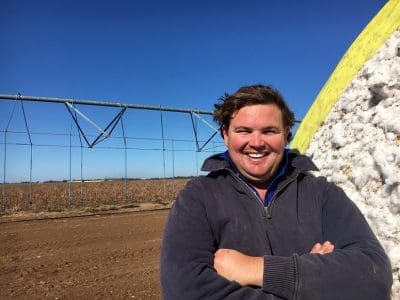COTTON grower and 2015 Nuffield Scholar, Tom Quigley, says ongoing issues around water availability prompted him to look at new techniques from around the world to help grow more profitable, water efficient and sustainable cotton crops using pressurised overhead sprinkler irrigation.

Cotton grower and 2015 Nuffield Scholar, Tom Quigley, set out to look at new techniques from around the world to help grow more profitable, water efficient and sustainable cotton. crops
Mr Quigley and his family manage a 1200-hectare irrigation property, alongside dryland cropping and livestock enterprises, in the NSW Macquarie Valley.
Since the implementation of the Murray-Darling Basin Plan in 2012, and as part of the Government’s incentive to modernise irrigation infrastructure, a large proportion of the district’s cotton farms swapped water rights to implement pressurised overhead sprinkler irrigation.
Having invested heavily in the new infrastructure, most notably Centre Pivots and Lateral Moves (CPLM) systems, Mr Quigley said it was clear the new technology wasn’t delivering the promised results of increased yield and reduced water use.
“The initial results were promising, however we weren’t seeing the full potential of these machines using existing cotton growing methods. We identified that we had to change our farming technique with the new infrastructure, in order to produce more, with less,” he said.
“I began researching new techniques and elements employed by other farmers around the world, which ultimately led to my Nuffield Scholarship, which was supported by Cotton Australia and the Cotton Research & Development Corporation.
“The scholarship enabled me to see first-hand the advances being made with similar sprinkler irrigation systems in countries like the United States, Canada, Brazil, Mexico, New Zealand and Israel.
“I talked to farmers who had 30 plus years’ experience utilising sprinkler irrigation and was able to bring that knowledge back home to help accelerate the change in practices on our own farm, as well as those around us.”
Mr Quigley’s findings uncovered several areas of improvement for growers: ranging from the need to have ground cover to adopting new systems like strip tillage, which has delivered significant gains for US farmers in corn production.
“There was a lot to take away from the whole experience at both a very technical and professional level,” he said.
“For instance, it became obvious that ground cover material must have enough lining and cellulose to resist decomposition until after row closure in the cotton crop.
“Introducing ground cover into the system came with its own set of challenges, and while planting cotton into fields with high ground cover residue is possible, it requires specialised equipment and a modified planter set up to achieve the desired results.
“Strip tillage overcomes a significant proportion of the challenges associated with groundcover, and can deliver significant yield increases as seen in the US. It’s a precision agriculture tool and highly beneficial in a cotton system under CPLM due to its ability to consolidate various processes in one pass.”
Mr Quigley’s research also found that sprinkler selection determines how water is delivered to the soil efficiently and will have the greatest influence in machine performance for minimal cost.
“There is a 10 per cent reduction in water use up for grabs just from sprinkler choice, which could be a $400/ha decrease in cost,” he said.
“Irrigation scheduling is completely different to traditional cotton farming systems. However, the same decision-making tools are relevant for furrow and sprinkler irrigated crops.
“Machine maintenance is of the highest importance because if a machine breaks down, there is zero capacity to irrigate the crop, which directly impacts the bottom line.
“To help counter this, preventative pre-season maintenance can minimise down time during the season and help prevent severe water stress.”
Ultimately, Mr Quigley hopes his Nuffield Scholarship report and, more broadly, his global experience will encourage other Australian growers to adopt new farming techniques and share these learnings with their peers.
“The cotton industry has a great history in sharing knowledge and helping each other to improve farming practices, so as to obtain greater water efficiency, yields and profitability,” he said.
“I hope what I’ve seen and learnt overseas helps other growers who are already utilising – or are thinking about utilising – sprinkler irrigation to grow cotton.
“Australian cotton has a very positive story to tell. We’re not only reducing water, chemical and energy use, we’re continuing to increase the quality of a product, that we know our customer’s love and enjoy.”
Source: Nuffield Australia, www.nuffield.com.au


HAVE YOUR SAY